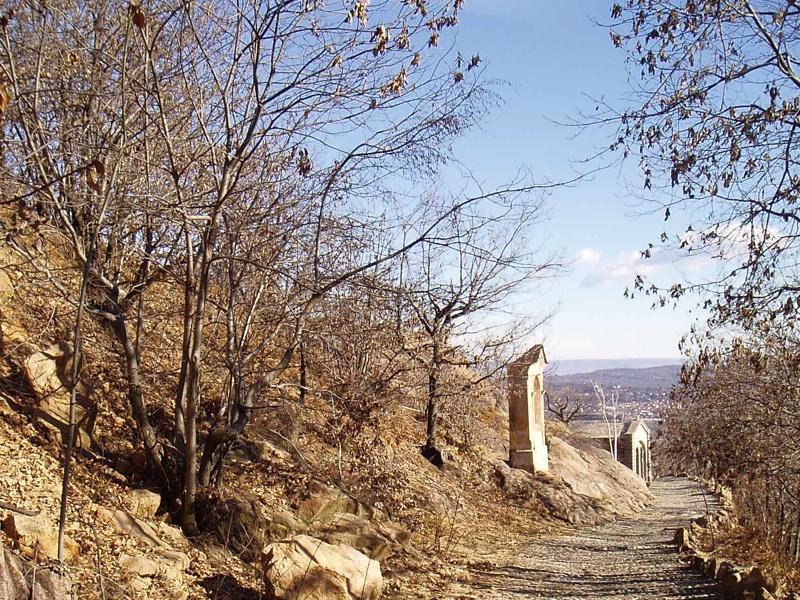Historical and Devotional Pedestrian Route
- Trail Conditions: On foot
- Interest: Religion, Hystory
- Departure: Belmonte
- Duration: 30 minutes
- Difficulty Level: T - Tourist (level)
- Recommended Period: from January to December
The Chapels forming Sacro Monte di Belmonte were built in the early 18th century. Between 1712 and 1825, the place seems to be surrounded by a particular atmosphere, since it develops on the summit of the hills behind the Romanesque-style Sanctuary, across a wood of centuries-old oaks and chestnut trees, interrupted here and there by big rocks of reddish granite. Four architectural typologies can be noticed: central octagonal plan, rectangular plan with polygonal pronaos and apse, circular plan with rectangular pronaos, square plan with rectangular pronaos. The main body houses a group of statues representing a moment of the Passion of Christ, while the opposite section, the pronaos, is dedicated to the believers.
The itinerary leaves from the barrier closing the passage to cars:
- Chapel no. 1 - Jesus in front of Pilate
The chapel, with circular plan and rectangular pronaos, was built in 1712. The frescoes on the vault, well preserved, are ascribed to the painter Grosso from Ivrea and date back to the 18th century. - Chapel no. 2 - Jesus is condemned to death
The chapel, with a circular plan, was built in 1714. - Chapel no. 3 - Jesus falls the first time
The chapel, with rectangular plan and pronaos, was built in 1715. The more recent restoration works were carried out in 2002. - Chapel no. 4 - Jesus meets His Mother
The chapel, with rectangular plan and pronaos, was built in 1713. - Chapel no. 5 - Simon of Cyrene carries the cross
The chapel, with rectangular plan and pronaos, was built in 1773. - Chapel no. 6 - Veronica wipes the face of Jesus
It is the farthest chapel, situated in a wonderful panoramic position, and marks we are halfway of the devotional route. It was built in 1712. It is the chapel suffering more damages and acts of vandalism: as a matter of fact, the group of statues was completely destroyed. At the beginning of the current century, it passed under the patronage of the Lawyer Aurelio De Andreis, who transformed it into a family Chapel, adding an apse with an altar and a small bell tower. - Chapel no. 7 - Jesus falls the second time
The chapel, with rectangular plan and pronaos, began to be built in 1715. The building was finished only in 1773. The vault of the Chapel was painted in fresco by the painter Grosso from Ivrea in 1773. - Chapel no. 8 - Jesus meets the daughters of Jerusalem
The Chapel, with circular plan and rectangular pronaos, began to be built by the friars of the monastery in an uncertain period and was finished in 1781 thanks to the support provided by some families from Busano. The vault still preserves the frescoes by the painter Grosso. The more recent restoration works were carried out in 2002. - Chapel no. 9 - Jesus falls the third time
The Chapel, with circular plan and rectangular pronaos, was built between 1759 and 1765. The group of statues is unique, since the five statues dating back to the beginning of the current century are in white plaster with no color. They stand out on the gloomy background. - Chapel no. 10 - Jesus is stripped from His garments
The chapel, with rectangular plan and pronaos, was built in the same years of the previous one and financed with the alms collected by the Sanctuary. - Chapel no. 11 - Crucifixion
The chapel, with rectangular plan and pronaos, was built in 1719. The more recent restoration works were carried out in 2002. - Chapel no. 12 - Jesus dies on the cross
The chapel is different from all the others both for its position, dominating the Sanctuary and the Monastery, and the Bramante-style shape (central octagonal plan with a large portico surrounding it). It was built in 1715 by Valperga Community which preserved the patronage and reconstructed it after the partial collapses of the second half of the 18th century and 1825. - Chapel no. 13 - Deposition
The Chapel, with circular plan and rectangular pronaos, is the last chapel of the devotional route, and the last to be built. As a matter of fact, it was built only in 1825.
In front of it, in the highest point of the mountain, there is the bronze statue representing St Francis. The statue was created by the sculptor Giovanni Vogliazzi from Vercelli, and was inaugurated on 3rd July 1960.
Road access: From Turin take SS 460 that, passing through Leinì, reaches Rivarolo Canavese and continues to Cuorgnè and along SP road 42, to Belmonte. The stretch from Turin to Cuorgnè is also served by SATTI bus and railway lines, tickets and timetables can be found in the departure station.
Where to Sleep:
B&B La Maddalena - Fraz. Ronchi Maddalena, loc. Fantini, 17 - Cuorgnè (TO) - Tel. 0124/68568 - mobile 349/4640393
Albergo Armony - Via Don Minzoni, 4 - Cuorgnè (TO) - Tel. 0124/657452
Where to Eat:
Prascorsano Bar Restaurant - La Società Coop. Via Villa, 23 - Tel. 0124/698135
Buasca - Restaurant Buasca - Fraz. Buasca - Tel. 0124/651115
Cuorgnè - Ramo Verde - Loc. Pedaggio Vl. Dei Mille, 2 - Tel. 0124/657219
Sant'Anna - Via S. Anna, 21 S. Anna - Campore - Tel. 0124/666584
S. Lucia - Loc. S.Lucia 6/B - Tel. 0124/657301








